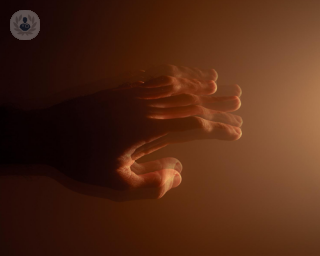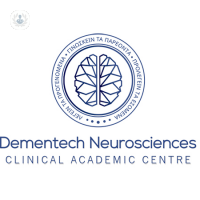Ataxia
Dr Dominic Paviour - Neurology
Created on: 10-28-2013
Updated on: 04-09-2024
Edited by: Carlota Pano
What is ataxia?
Ataxia is the term for a group of neurological disorders that affect muscle control, causing difficulties with balance, coordination and speech. There are different types of the disorders that can affect people in different ways. Any part of the body can be affected by ataxia but overall people have difficulties with:
- Balance and walking: People with ataxia have an unstable gait, which causes an increased tendency to rely on the body's support base when walking. Instability can also affect the trocar in advanced ataxia, making it difficult to stay in a seated position.
- Speaking: People with ataxia have problems with the clarity of their speech, due to difficulties controlling the volume of their tone, their voice and their breath.
- Swallowing and eating: This can cause coughing, choking when eating or drinking, and having to swallow several times, which increases the risk of food travelling to the lungs.
- Writing: People with ataxia may experience difficulties to hold the tip of the pen and to form letters.
- Vision: This can lead to the development of eye conditions, including double vision (diplopia) or involuntary eye movements (nystagmus).
- Co-ordination: This generally affects arm and leg movements, which causes issues with accuracy, control and stability. For this reason, people with ataxia can also experience tremors.

What are the different types of ataxia?
There are many different types of ataxia, which can be divided into three main categories:
Acquired ataxia: This type of ataxia may occur due to traumatic brain or nerve injury, such as from a stroke, a brain tumour, multiple sclerosis or nutritional deficiencies that can have an effect on the brain, affecting movement and co-ordination. The condition affects people of any age, typically progressing very quickly.
Hereditary ataxia: This runs in the family and is inherited, caused by a defective gene that is passed from parents to children. Symptoms develop slowly over several years.
The commonest inherited progressive ataxia is Friedreich's ataxia. Signs and symptoms include: wobbliness, clumsiness, falls, dysarthria, weakness in the legs, dysphagia, scoliosis, total or partial loss of vision and hearing, diabetes, hypertrophic cardiomyopathy and peripheral neuropathy. The first symptoms of Friedreich's ataxia usually appear before the age of 25 and then worsen over time, causing life expectancy to be shorter than normal.
Idiopathic late-onset cerebella ataxia (ILOCA): In this type of ataxia, the cerebellum (a certain part of the brain) is progressively damaged due to unexplained causes. These ataxias are rare and begin around the age of 50, slowly worsening with time.
What causes ataxia?
Ataxia is the result of damage to the cerebellum, the part of the brain that is responsible for muscle co-ordination and movement, and its connection to the brainstem but it can also be caused from damage to other parts of the nervous system, such as the spinal cord.
There are many underlying causes of ataxia, such as multiple sclerosis, brain degeneration or excessive alcohol consumption. Many ataxias are inherited because of defects in certain genes.
What are the symptoms of ataxia?
The signs of ataxia include:
- Poor co-ordination
- Inability to walk steadily
- Difficulty with eating, writing or tasks such as buttoning a shirt
- Change in speech, slurring
- Involuntary back and forth eye movements
- Trouble swallowing
- Loss of balance
The severity of symptoms and the progression of ataxia can vary, depending on the exact type of ataxia and the characteristics of each individual, including genetic and environmental factors.
How is ataxia diagnosed?
The diagnosis of ataxia starts with an analysis of symptoms and a neurological assessment that analyses balance, co-ordination and walk. The doctor will ask about the individual's family history to check for the presence of ataxia that could be genetically caused. In addition, the doctor may also ask about the individual's alcohol consumption and prescribed medications. This is because certain medications and excessive alcohol intake can produce symptoms that are similar to ataxia.
Blood and urine tests may then be ordered to rule out other possible causes for the symptoms.
After this, further testing will be carried out, including:
- Genetic testing: These tests can detect the genetic mutations of Friedreich's ataxia, ataxia-telangiectasia and spinocerebellar types of ataxia.
- Brain imaging scans, such as CT and MRI scans. These tests check for brain tumours and physical conditions that could cause ataxia.
Additional tests that can be carried out to identify ataxia and determine its severity are a lumbar puncture to analyse the cerebrospinal fluid; an electromyography to analyse electrical acitvity; a videofluoroscopy X-ray; an electrocardiogram or an echocardiogram.
How is ataxia treated?
There is no cure for ataxia and supportive, personalised treatment to control symptoms is required. This helps to improve symptoms and helps to cope with living with ataxia.
Treatment may include:
- Speech and language therapy: To improve speech and swallowing difficulties
- Physiotherapy: To improve movement
- Occupational therapy: To improve day-to-day management of living with ataxia
These treatment options are often combined with medication to improve symptoms. Medication can help to to control muscle, bladder, heart and eye problems.
What is the outlook for ataxia?
The outlook on life with ataxia depends on what type of ataxia a person is coping with. Some types are able to remain stable or even improve over time. Unfortunately, most will get progressively worse over many years.
Life expectancy is short for people with hereditary ataxia with people living into their 60s. In some severe cases, the condition can be fatal in childhood.
Doctors can treat the underlying cause with medication. There is ongoing research to find a cure for ataxia.
Which specialist treats ataxia?
A neurologist will perform the necessary diagnostic tests to confirm the presence of ataxia and determine a personalised treatment plan.
Ataxia with vitamin E deficiency
Deficiency or absence of vitamin E, vitamin B-12, vitamin B-1 and vitamin B-6 can cause certain types of ataxia.
Ataxia with vitamin E deficiency is a rare form of ataxia that develops progressively, with the age of onset ranging from 3 to 62 years of age. In this type of ataxia, vitamin E levels are severely reduced or completely absent, depending on each patient.
People with this type of disorder may experience:
- Dysarthria
- Unsteadiness with gait
- Lack of hand co-ordination
- Areflexia (absence of reflexes)
Treatment involves oral doses of viamin E supplements to restore levels, and supportive care.
What is the difference between ataxia and apraxia and dyspraxia?
Ataxia is a neurological disorder that affects the ability to control and co-ordinate muscles and balance.
On the other hand, apraxia is the inability to carry out movements due to an injury in the cerebrum (another part of the brain) that causes difficulties understanding commands, despite the individual having the wish and the physical ability to perform these movements. People who are affected by apraxia can effectively perform movements in spontaneous situations, but they have difficulties executing them when required under verbal instructions or in situations with no context.
Dyspraxia causes the partial loss of this ability, being less severe than apraxia.





